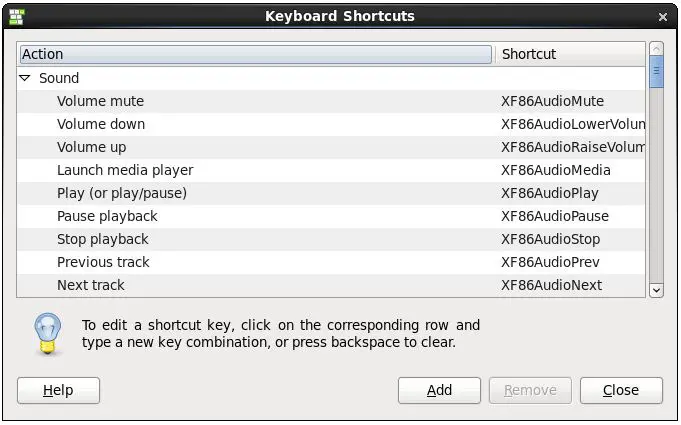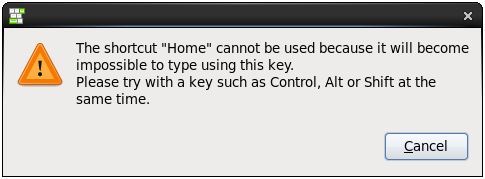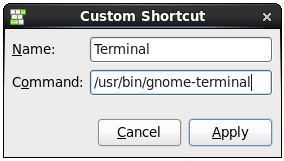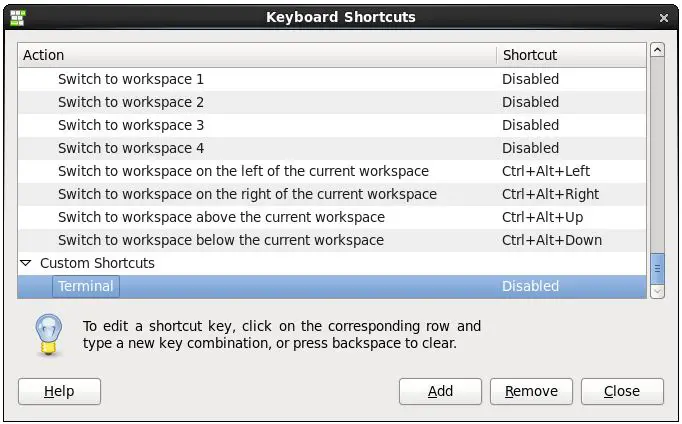Difference between revisions of "Configuring RHEL 6 Desktop Keyboard Shortcuts"
m (Text replacement - "<htmlet>ezoicbottom</htmlet>" to "") |
m (Text replacement - "<table border="0" cellspacing="0">" to "<table border="0" cellspacing="0" width="100%">") |
||
| (One intermediate revision by the same user not shown) | |||
| Line 1: | Line 1: | ||
| − | <table border="0" cellspacing="0"> | + | <table border="0" cellspacing="0" width="100%"> |
<tr> | <tr> | ||
<td width="20%">[[RHEL 6 Desktop - Starting Applications on Login|Previous]]<td align="center">[[Red Hat Enterprise Linux 6 Essentials|Table of Contents]]<td width="20%" align="right">[[Using the Bash Shell on Red Hat Enterprise Linux 6|Next]]</td> | <td width="20%">[[RHEL 6 Desktop - Starting Applications on Login|Previous]]<td align="center">[[Red Hat Enterprise Linux 6 Essentials|Table of Contents]]<td width="20%" align="right">[[Using the Bash Shell on Red Hat Enterprise Linux 6|Next]]</td> | ||
| Line 57: | Line 57: | ||
| + | <htmlet>ezoicbottom</htmlet> | ||
<hr> | <hr> | ||
| − | <table border="0" cellspacing="0"> | + | <table border="0" cellspacing="0" width="100%"> |
<tr> | <tr> | ||
<td width="20%">[[RHEL 6 Desktop - Starting Applications on Login|Previous]]<td align="center">[[Red Hat Enterprise Linux 6 Essentials|Table of Contents]]<td width="20%" align="right">[[Using the Bash Shell on Red Hat Enterprise Linux 6|Next]]</td> | <td width="20%">[[RHEL 6 Desktop - Starting Applications on Login|Previous]]<td align="center">[[Red Hat Enterprise Linux 6 Essentials|Table of Contents]]<td width="20%" align="right">[[Using the Bash Shell on Red Hat Enterprise Linux 6|Next]]</td> | ||
Latest revision as of 20:02, 27 October 2016
| Previous | Table of Contents | Next |
| RHEL 6 Desktop - Starting Applications on Login | Using the Bash Shell on Red Hat Enterprise Linux 6 |
|
You are reading a sample chapter from the RHEL 6 Edition book. Purchase the fully updated Red Hat Enterprise Linux 8 (RHEL 8) Edition of this publication in eBook ($9.99) or Print ($36.99) format Red Hat Enterprise Linux 8 Essentials Print and eBook (ePub/PDF/Kindle) editions contain 31 chapters and over 250 pages |
Ever since the advent of the graphical user interface we have been immersed in a world of pointers, mouse movements and clicks. With all this ease of use it is easy to forget that it can often be quicker to trigger something using the keyboard than to navigate through an array of menu options. This is achieved through a concept known as either keyboard shortcuts or keyboard accelerators. In this chapter we will look at the use and configuration of these shortcuts in the context of the RHEL 6 GNOME Desktop.
Viewing Keyboard Shortcuts
The GNOME desktop has a set of predefined actions to which a keyboard shortcut may be assigned. By default some of these actions already have a key sequence assigned to them. Other actions are disabled by default. As a user you have the power to view the current shortcut settings, change or disable currently configured shortcuts and to assign shortcuts to disabled actions. To view the current configuration, select the System -> Preferences -> Keyboard Shortcuts menu option. The following dialog will subsequently appear listing the current keyboard shortcut settings: <google>RHEL6BOX</google>
The shortcuts are broken down into categories; Sound, Desktop, Accessibility and Window Management. The above figure shows the Sound shortcut category. Scrolling through the list will give you a good overview of which shortcuts are currently configured and which key sequences are assigned.
Changing a Shortcut
A new shortcut may be assigned to an action simply by clicking on the current shortcut value in the list. The current setting will change to New shortcut. At this point press the key sequence you wish to associate with the corresponding action. For example, you might want to assign Ctrl+H to the Home Folder action such that pressing Ctrl+H causes the file manager to open at the current user's home folder.
Note that if you press a key sequence that is inappropriate for use as a shortcut a warning dialog will appear instructing you to make a different selection:
Disabling a Keyboard Shortcut
A keyboard shortcut may be disabled simply by clicking on the shortcut in the Keyboard shortcuts dialog and pressing the Back Space key. The selected shortcut will subsequently display a Disabled status.
Adding a Custom Shortcut
In addition to disabling or modifying the existing shortcuts, it is also possible to configure custom keyboard shortcuts. For the purposes of providing an example, assume that we wish to launch a terminal window when the Ctrl+T keyboard combination is triggered. To implement this functionality, begin by clicking on the Add button located at the bottom of the Keyboard Shortcuts dialog. In the resulting Custom Shortcut dialog, enter a name for the shortcut (for example, Terminal) and the path the terminal executable file (/usr/sbin/gnome-terminal):
Clicking the Apply button will create the shortcut which, in turn, will appear under the Custom heading in the preferences dialog:
As illustrated in the above figure, the shortcut is disabled until a keyboard sequence is assigned to it. Select the new entry and press Ctrl+T to configure the shortcut and close the shortcuts window. Pressing Ctrl+T should now cause a new Terminal window to appear.
|
You are reading a sample chapter from the RHEL 6 Edition book. Purchase the fully updated Red Hat Enterprise Linux 8 (RHEL 8) Edition of this publication in eBook ($9.99) or Print ($36.99) format Red Hat Enterprise Linux 8 Essentials Print and eBook (ePub/PDF/Kindle) editions contain 31 chapters and over 250 pages |
| Previous | Table of Contents | Next |
| RHEL 6 Desktop - Starting Applications on Login | Using the Bash Shell on Red Hat Enterprise Linux 6 |









